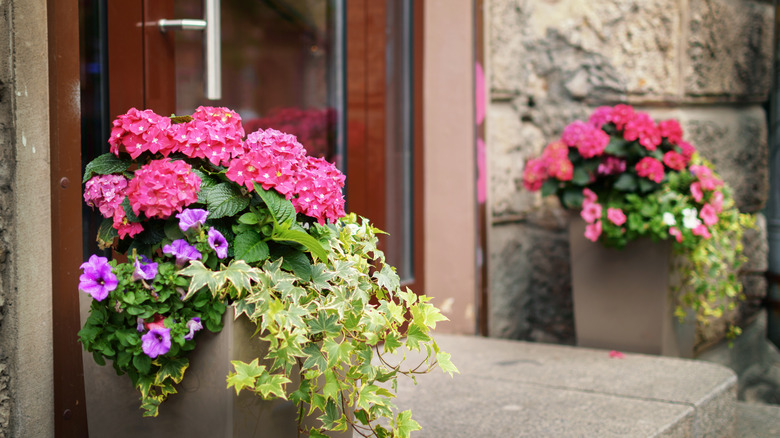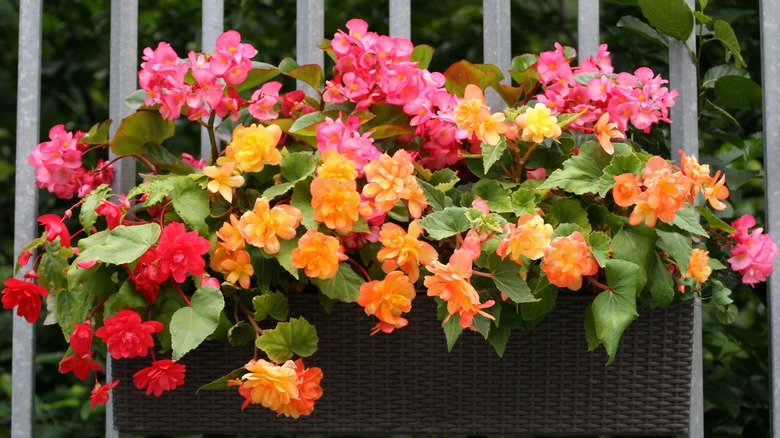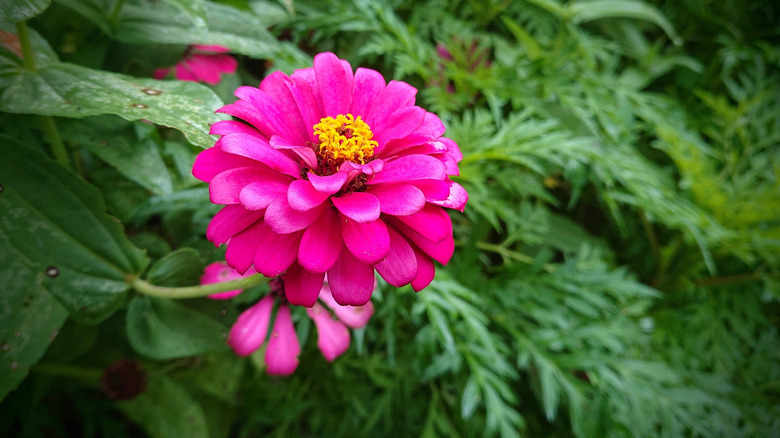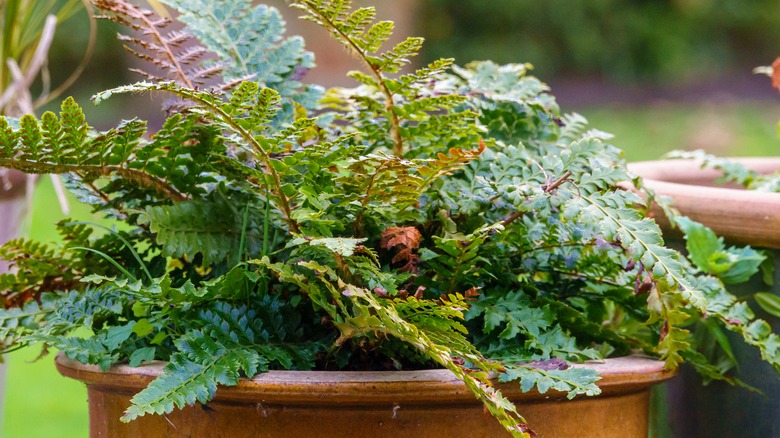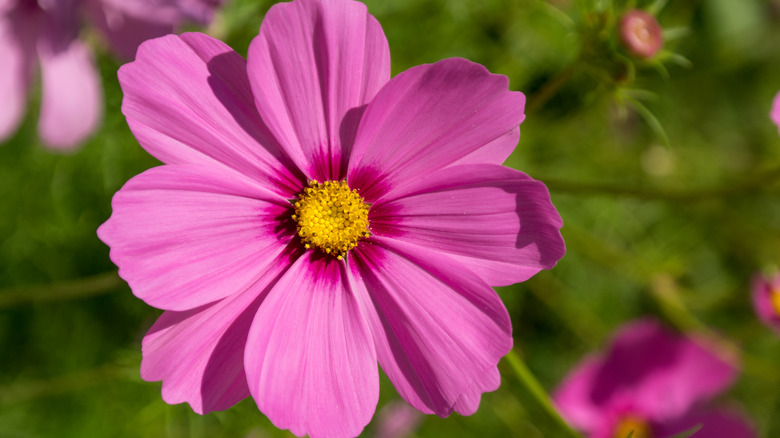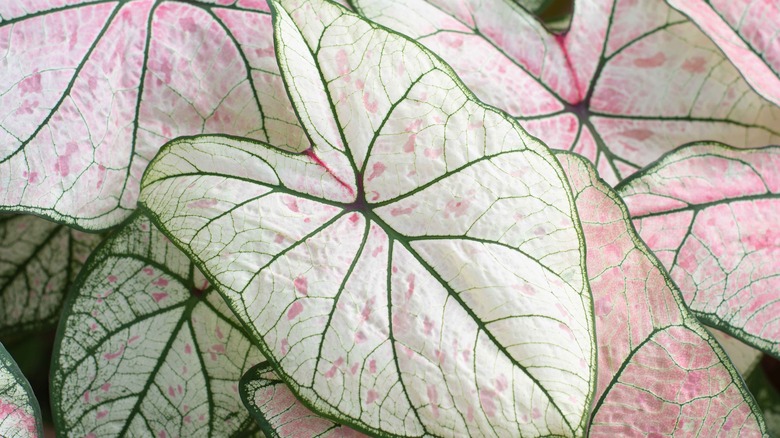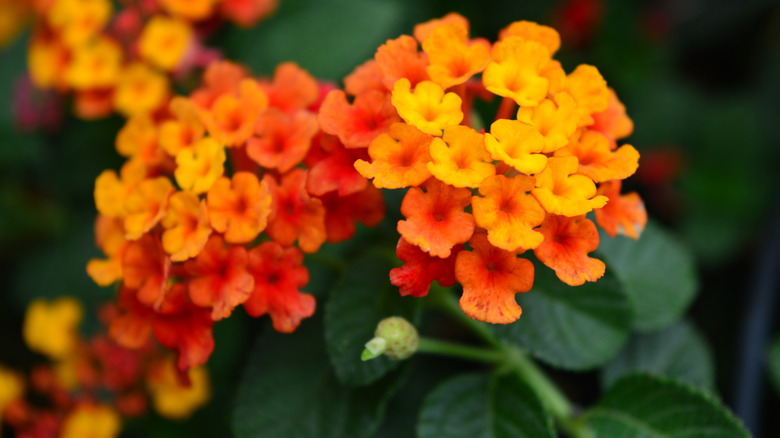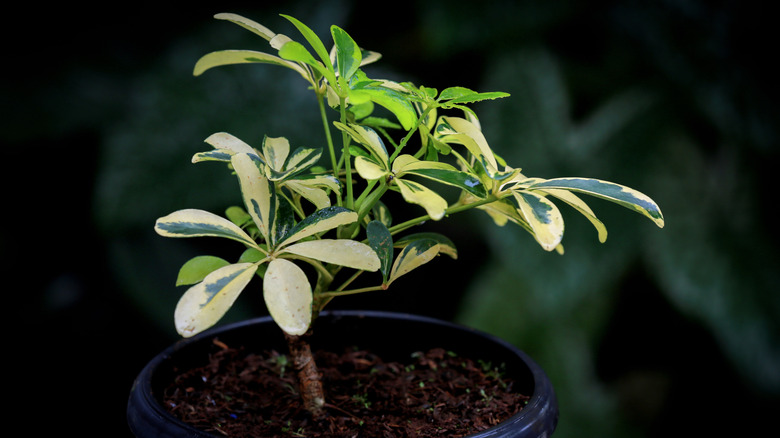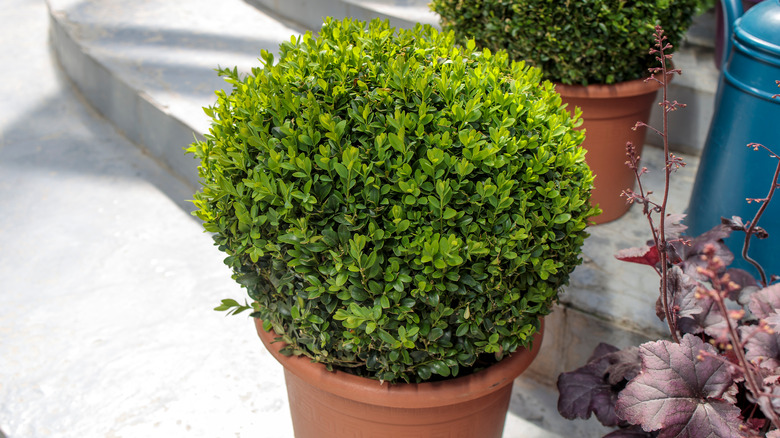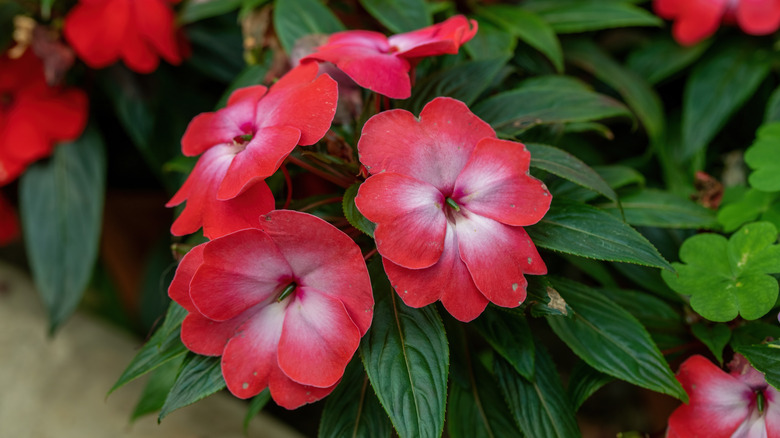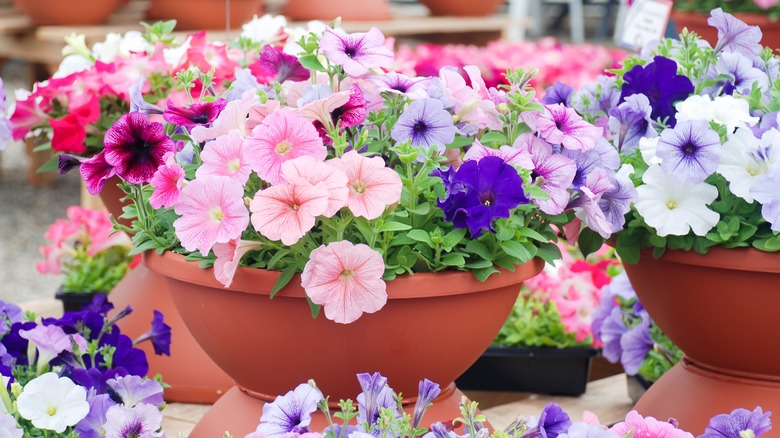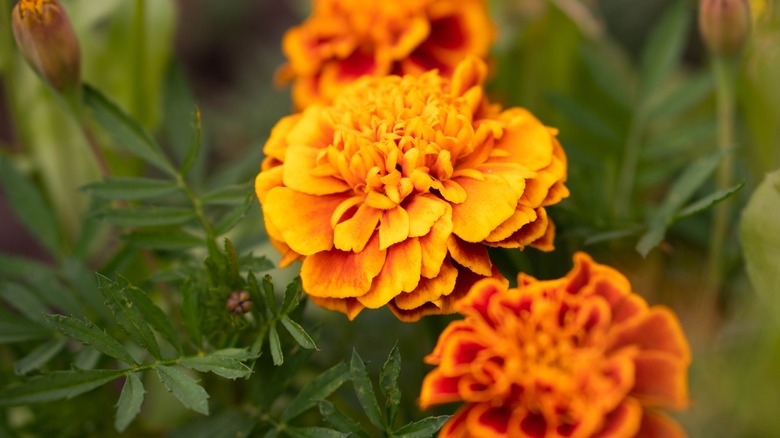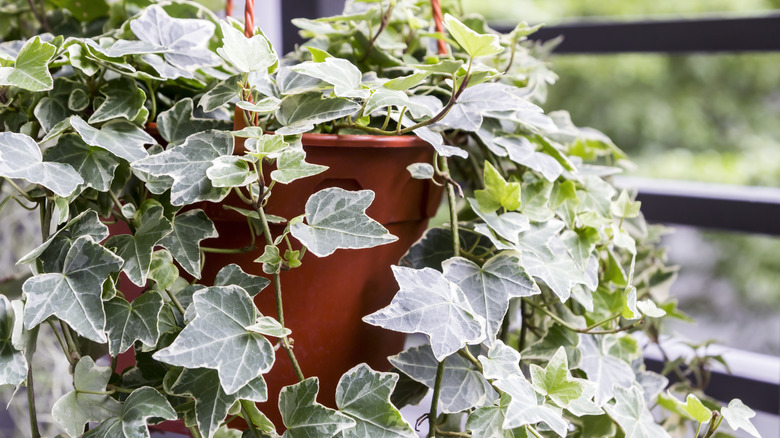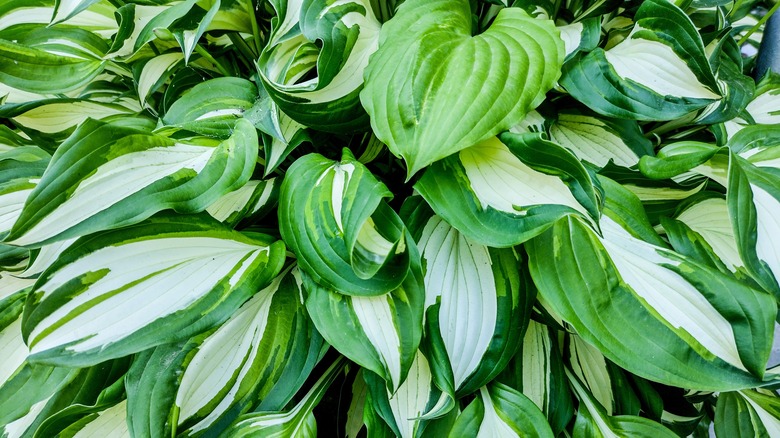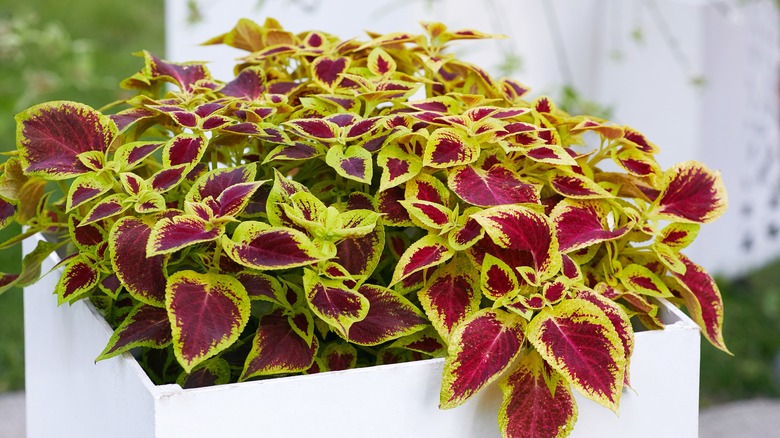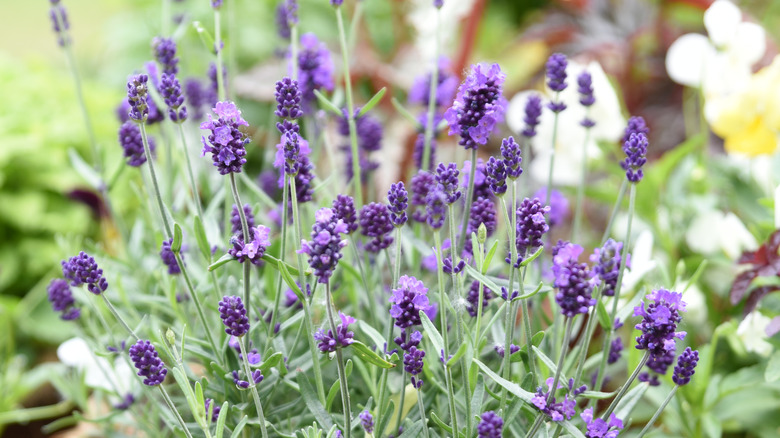15 Container Plants Perfect For Your Front Porch
Not much adds more curb appeal to the front of your home than plenty of thriving plants living on your porch. From blossoming flowers to lively evergreen shrubs, it's easy to give your guest a warm welcome before they even make it to your door. Container plants make it simple to freshen up your front porch with color and texture without committing to a high-maintenance garden. Instead, you can switch out your favorite flowers and plants as you please.
As suggested by Monrovia, you may grow flowers such as lantana and lavender right outside your front door when you understand their care requirements. Before deciding which flower or flowers you want to go with, be sure to know your USDA zone. Also consider how much heat, water, and sunlight your area will be able to provide your container plants with. With the right amount of research and care, your plants can last all summer or longer.
1. Begonia
Begonias (Begonia spp.) make great container plants as they produce gorgeous foliage and flowers. Depending on the cultivar that is planted, your begonia plant may do better in partial shade or full sun, as per Clemson Cooperative Extension. When kept on your front porch, you may be able to provide it with both conditions throughout the day.
Bloom Season: Late spring and summer
USDA Growing Zone: 7 to 11 depending on the cultivar
Growing Conditions: Organic, moist, and well-draining
Soil Type: Partial shade to full sun
Size: Between 8 to 24 inches tall
2. Zinnias
Zinnias (Zinnia spp.) are an extremely popular flower year-round in warmer states such as California and Florida. However, they make great annuals in colder states too, as told by Penn State Extension. Though they are great in the garden where they attract pollinators such as bees and butterflies, they also look amazing in front of your house. During their blooming season, they welcome you and your guests with a bright pop of color.
Bloom Season: Summer
USDA Growing Zone: 9 to 11
Growing Conditions: Full sun
Soil Type: Well-draining
Size: 6 inches to 3 feet tall
3. Boston Fern
The Boston fern (Nephrolepis exaltata 'Bostoniensis') is a medium-sized fern that can be used outdoors or indoors as a houseplant. It is easily identified by its broad fronds that are typically lime green in color, as explained by the University of Wisconsin-Madison. When planting, you can decide to keep them in a container, a hanging basket, or on a plant stand.
Bloom Season: Does not flower
USDA Growing Zone: 9 to 11
Growing Conditions: Partial shade to full sun
Soil Type: Rich and well-draining
Size: Up to 7 feet tall
4. Cosmos
Cosmos (Cosmos spp.) make wonderful container flowers as they bloom profusely and require little maintenance. However, you should keep in mind that they can grow quite tall. According to Almanac, there are three main cosmos species that you can buy. Each of them are very similar but they feature their own special traits that may encourage you to pick one over the other.
Bloom Season: Summer to fall
USDA Growing Zone: 2 to 11
Growing Conditions: Full sun
Soil Type: Well-drained loam, sand, or chalk
Size: Up to 5 feet tall depending on the cultivar
5. Caladium
Caladiums (Caladium spp.) grow best in planters on your front porch that you can move inside or outside depending on the weather, as explained by Longfield Gardens. You may also choose to plant yours in a window box, along walkways, or in your flower garden. Though these plants rarely bloom, they will add some interest to the front of your home.
Bloom Season: Summer
USDA Growing Zone: 9 to 11
Growing Conditions: Partial shade to full shade
Soil Type: Well-drained and fertile
Size: Up to 30 inches tall
6. Lantana
Lantana (Lantana camara) is a part of a genus of more than 100 species that are all very attractive to gardeners and pollinators alike, says the University of Wisconsin-Madison. The common lantana is often grown in containers outdoors where it takes a small bushy shape that fills with flowers during the spring.
Bloom Season: Spring
USDA Growing Zone: 8 to 10
Growing Conditions: Full sun
Soil Type: Well-drained
Size: Up to 6 feet tall, smaller when container-grown
7. Umbrella tree
The umbrella tree (Schefflera arboricola) is also known as the dwarf Schefflera. It is an evergreen shrub that needs warm weather and little water to survive. Because of this, it is often kept indoors as a houseplant. Though, if you can keep it outdoors, it has a higher likelihood of flowering in the summer, as per North Carolina State Extension.
Bloom Season: Summer
USDA Growing Zone: 10 to 12
Growing Conditions: Full sun to partial shade
Soil Type: Well-drained and loamy
Size: 6 feet tall and 3 feet wide
8. Boxwood
Boxwood shrubs (Buxus spp.) are used all over the United States and in many other countries too. These plants are adaptable to many climates and soil types, which makes them easy to grow and maintain, as pointed out by Proven Winners. These evergreen shrubs are great for planting on your lawn, but they also look great in containers when they can be pruned into fun shapes.
Bloom Season: Spring
USDA Growing Zone: 4 to 9
Growing Conditions: Partial shade
Soil Type: Well-drained
Size: 1 to 20 feet tall and 2 to 8 feet wide
9. New Guinea Impatiens
New Guinea Impatiens (Impatiens hawkeri) are much like standard impatiens except they are larger, notes Missouri Botanical Garden. If you are looking for a show-stopping, shade-loving plant, this one is for you. New Guinea Impatiens look great in hanging planters, window planters, and containers.
Bloom Season: Flowers freely
USDA Growing Zone: 10 to 12
Growing Conditions: Part shade
Soil Type: Well-drained and organically rich
Size: 4 feet tall to 3 feet wide, smaller when container-grown
10. Petunias
Petunias (Petunia spp.) are flowers of many colors. People all over the world love planting petunia species in front of their homes because there are so many varieties to choose from. From velvety black to hot pink, there is a color for every home. Plus, they are fragrant, low-maintenance, and they are well-suited to container growing, as told by the University of Minnesota Extension.
Bloom Season: Spring
USDA Growing Zone: 10 to 11
Growing Conditions: Full sun
Soil Type: Well-draining
Size: 6 to 15 inches tall depending on the cultivar
11. Marigolds
Marigolds (Tagetes spp.) are frequently chosen for their long-lasting blooms that are typically yellow, orange, red, or gold, as explained by Clemson Cooperative Extension. French marigolds and African marigolds are most often grown in flower gardens, containers, border plantings, or used for cut flowers.
Bloom Season: Summer
USDA Growing Zone: 2 to 11 as annuals
Growing Conditions: Full sun
Soil Type: Well-drained and loamy
Size: 6 inches to 3 feet tall depending on the cultivar
12. English Ivy
English Ivy (Hedera helix) is a climbing vine that is also known as California ivy, branching ivy, and sweetheart ivy, as mentioned by North Carolina State Extension. Outdoors, the plant can be weedy and aggressive as it chokes out trees, shrubs, and flowers. When growing English ivy in a container, it will tolerate many soil types, but it will not usually tolerate full sun.
Bloom Season: Fall and summer
USDA Growing Zone: 4 to 13
Growing Conditions: Full sun to partial shade
Soil Type: Moist, well-draining
Size: Grows up to 80 feet long outdoors, much smaller grown inside
13. Hosta
Hostas (Hosta plantaginea) are well-known for their wide leaves and their purple flowers. They can be planted outdoors in your garden or as border plantings. However, they do just as well in containers on your front porch. Luckily, they are cold-hardy and can survive year-round even in northern states, as per UIC Heritage Garden.
Bloom Season: Mid-summer
USDA Growing Zone: 3 to 9
Growing Conditions: Partial shade
Soil Type: Well-draining
Size: 2 inches to 3 feet tall and 4 inches to 5 feet wide
14. Coleus
Coleus (Coleus spp.) is an annual plant that is grown for its brightly colored foliage. Though, it does produce flowers in the later part of spring. They are often pinched off to help the foliage grow more profusely. Its leaves look similar to mint leaves, and they can be yellow, pink, red, or green, according to the University of Minnesota Extension.
Bloom Season: Spring and fall
USDA Growing Zone: 10 to 11
Growing Conditions: Full shade to full sun depending on the cultivar
Soil Type: Well-drained
Size: 6 to 36 inches tall
15. Lavender
Lavender plants (Lavandula angustifolia) produce wonderfully aromatic flowers that are commonly used in perfumes, sachets, and potpourris, as noted by Missouri Botanical Garden. Also called true lavender, this herbaceous perennial can be grown on your front porch to welcome guests with a fresh, floral scent before they enter your home.
Bloom Season: Summer
USDA Growing Zone: 5 to 8
Growing Conditions: Full sun
Soil Type: Well-drained
Size: 3 feet tall and 4 feet wide
